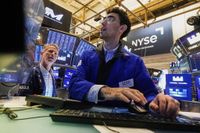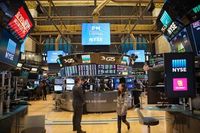World markets started the week on a cautious note as investors braced for a flurry of high-stakes political meetings and economic signals, with the spotlight firmly fixed on U.S. President Donald Trump’s scheduled talks with Ukrainian President Volodymyr Zelenskyy and a cohort of European leaders. This diplomatic gathering, set for Monday, August 18, 2025, comes just days after Trump’s inconclusive summit with Russian President Vladimir Putin in Anchorage, Alaska—a meeting that left many questions about the path forward in Ukraine.
As reported by the Associated Press, global shares reflected this uncertainty. Germany's DAX slipped 0.2% to 24,303.26, Paris’ CAC 40 dropped 0.5% to 7,881.74, and Britain’s FTSE 100 remained nearly flat at 9,137.31. Futures for the S&P 500 and the Dow Jones Industrial Average edged down 0.1%. Meanwhile, in Asia, the mood was mixed but largely optimistic: Japan’s Nikkei 225 climbed 0.8% to 43,714.31, marking a fresh record high, while the Hang Seng in Hong Kong lost 0.4% to close at 25,176.85. The Shanghai Composite index jumped 1% to 3,732.44, flirting with its highest level in a decade, and Australia’s S&P/ASX 200 rose 0.2% to 8,959.30.
South Korea’s Kospi, however, wasn’t so lucky, tumbling 1.5% to 3,177.28 amid heavy selling in semiconductor stocks. Samsung Electronics shares fell 2.2%, and SK Hynix lost 3.3%, as investors grew anxious about the possibility of more U.S. tariffs on computer chips—a ripple effect from Trump’s ongoing trade policies.
According to Reuters, the anticipation for Trump’s meeting with Zelenskyy and European leaders was palpable. Unlike the previous discussions with Putin, which excluded European allies, this round was expected to present a more unified Western stance on safeguarding Ukraine and the broader continent from further Russian aggression. Yet, as of Monday morning, concrete proposals remained elusive. Trump, appearing more aligned with Moscow’s preference for a peace deal over a ceasefire, was set to discuss next steps, but details were thin on the ground.
The political theater wasn’t the only thing keeping investors on their toes. The annual Jackson Hole symposium in Wyoming, a key event for the global financial community, was slated to begin later in the week. Federal Reserve Chair Jerome Powell was scheduled to speak on Friday, August 22, 2025, and markets were hungry for clues about the central bank’s next move. The official theme of the conference was labor markets, but, as Ipek Ozkardeskaya of Swissquote pointed out in a client note, “investors will scrutinize any hint of September policy direction, especially after last week’s mixed inflation data.”
Expectations for a rate cut at the Fed’s September meeting had been building, with the CME Group’s FedWatch tool showing traders pricing in an 84.8% chance of a 25-basis-point cut. The rationale is straightforward: lower global borrowing costs could further buoy markets, as they make it cheaper for households and businesses to borrow and invest. But there’s a flip side—such moves also risk stoking inflation, a concern that’s not lost on either central bankers or consumers.
Last week’s U.S. economic data painted a muddled picture. According to the Associated Press, retail spending increased as expected, and manufacturing in New York state unexpectedly grew. But industrial production nationwide shrank, and consumer sentiment, as measured by the University of Michigan, worsened due to persistent worries about inflation. Joanne Hsu, director of the University of Michigan’s surveys of consumers, remarked, “Overall, consumers are no longer bracing for the worst-case scenario for the economy feared in April. However, consumers continue to expect both inflation and unemployment to deteriorate in the future.”
Against this backdrop, Wall Street saw a modest retreat from its record highs. On August 15, 2025, the S&P 500 slipped 0.3% from its all-time high set the previous day, closing at 6,449.80. The Dow Jones Industrial Average inched up 0.1% to 44,946.12, while the Nasdaq composite dipped 0.4% to 21,622.98, still hovering near its own record. Yet, the broader trend remained bullish: the S&P 500 had just closed its fourth winning week out of the last five.
Strong corporate earnings continued to underpin U.S. markets. As Bloomberg reported, S&P 500 earnings per share grew 11% year-on-year, with 58% of companies raising their full-year guidance. The so-called “Magnificent 7” tech giants delivered a collective 26% year-on-year earnings per share growth in the second quarter, surpassing consensus expectations by 12%. UnitedHealth Group was a particular standout, jumping 12% after Warren Buffett’s Berkshire Hathaway disclosed a $1.57 billion stake. However, not all news was rosy: Applied Materials fell 14.1% despite beating quarterly estimates, as investors fretted over a forecasted revenue drop and ongoing uncertainty in its China business. Sandisk slipped 4.6% after offering a weaker profit outlook for the current quarter.
Internationally, Shanghai’s index rose 0.8% on August 15, 2025, while Hong Kong’s fell 1% amid mounting concerns over China’s economic slowdown—anxiety that ING Economics attributed to a “dynamic macroeconomic and policy environment,” including the ongoing trade tensions with the U.S. Japan’s Nikkei 225, meanwhile, soared 1.7% after the government reported better-than-expected quarterly growth, offering a rare bright spot in the region.
Commodities also reflected the week’s cautious optimism. On Monday, U.S. benchmark crude oil rose 7 cents to $62.87 per barrel, while Brent crude climbed 3 cents to $65.88. Spot gold was up 0.64% to $3,356.33, having hit its lowest level since August 1, and U.S. gold futures for December delivery gained 0.60% to $3,402.90. In currency markets, the U.S. dollar strengthened to 147.37 Japanese yen from 147.18 yen, while the euro slipped to $1.1682 from $1.1703.
Bond yields edged higher as well. On August 15, the yield on the 10-year U.S. Treasury rose to 4.31% from 4.29%, and the two-year yield climbed to 3.75% from 3.74%, signaling a market still digesting the mixed signals from both economic data and central bank communications.
As the week unfolds, all eyes will remain on the interplay between geopolitics and global finance. With Trump’s meetings and the Jackson Hole symposium on the horizon, investors and policymakers alike are preparing for a pivotal stretch—one that could shape the economic and diplomatic landscape for months to come.

